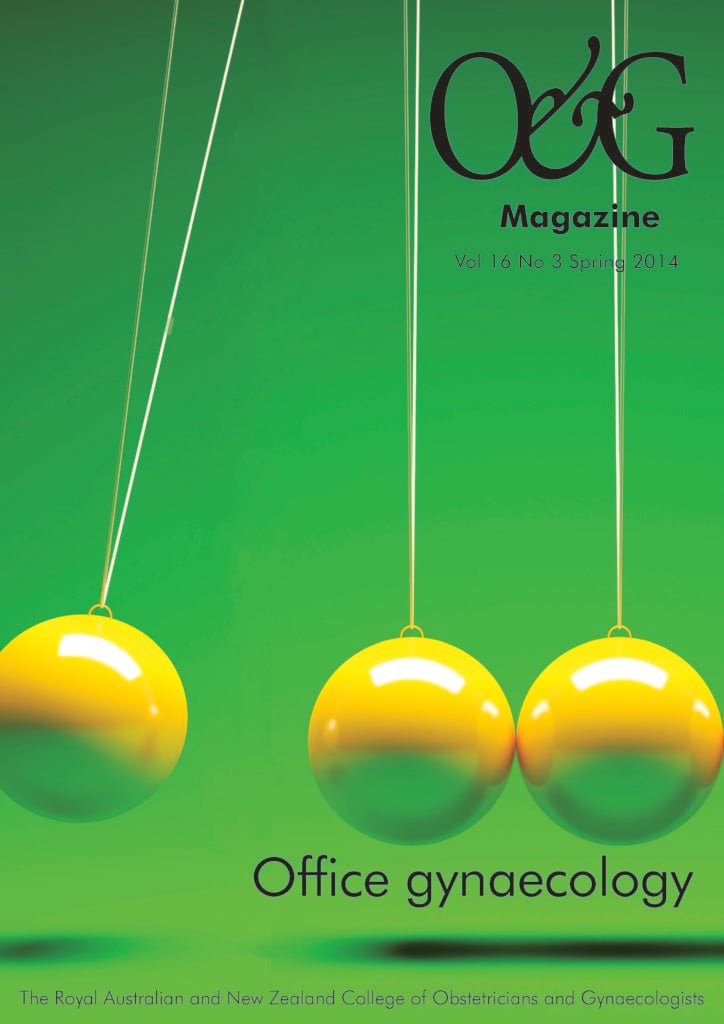Had time to read the latest journals? Catch up on some recent O and G research by reading these mini-reviews by Dr Brett Daniels.
Caesarean wound closure
With approximately 30 per cent of births in Australia by caesarean section (CS), research into technique and complications of a common operation are of interest to most obstetricians. Mackeen et al recently reported a randomised trial comparing wound complications for different skin closure methods.1 In the trial, 746 women having a low transverse incision for CS, were randomised to have skin closure with either stainless steel staples or subcuticular 4-0 polyglactin or poliglecaprone suture. Staples were removed between four and ten days after surgery at the surgeon’s discretion. The percentage of women having at least one wound complication (infection, haematoma, seroma, wound separation) was 4.9 per cent for the suture group and 10.6 per cent for the staple group (OR=0.43 [0.23-0.78]). The result was most marked for wound separation, 1.6 per cent in the suture group and 7.4 per cent in the staple group, respectively (OR=0.20 [0.07-0.51]). A previous review by the same primary author reported wound separation with staples increased if staples were removed on day four rather than later.2 The current study further found the time for skin closure with sutures was significantly longer than with staples (median duration 15 and six minutes, respectively). It may be that many obstetricians will be prepared to take the extra time for suture skin closure to achieve the reduction in complications demonstrated in this paper.
- Mackeen AD, Khalifeh A, Fleisher J, et al. Suture compared with staple skin closure after cesarean delivery. 2014. Obstet Gynecol, 123: 1169-1175.
- Mackeen AD, Berghella V, Larsen ML. Techniques and materials for skin closure in caesarean section. Cochrane Database Syst Rev 2012 Sep 12;9:CD003577. doi: 10.1002/14651858. CD003577.pub2..
Nursing staffing and mortality
Many readers will have experienced first hand the effect of budgetary constraints on staffing within their hospitals. This may be in terms of absolute staff numbers or in the replacement of some staff with less-qualified and cheaper alternative workers. This phenomenon is not limited to Australia and New Zealand and European countries are subject to the same pressures. This large retrospective study analysed the discharge data for more than 400 000 patients having common general, orthopaedic or vascular surgeries in 300 hospitals across nine European countries (Belgium, Finland, Ireland, the Netherlands, Norway, Spain, Sweden, Switzerland and the UK). The results of the study showed that both nursing staffing levels and level of nursing education were significantly associated with mortality. With the dependent variable being likelihood of an inpatient dying within 30 days of admission for surgery, the authors found that an increase in nursing workload by one patient per nurse increased the mortality rate by seven per cent, while increasing the number of degree-qualified nurses by ten per cent decreased this likelihood by seven per cent. For example, hospitals in which 60 per cent of nurses had degrees and cared for an average of six patients would have a 30 per cent lower mortality than hospitals in which only 30 per cent of nurses had degrees and cared for an average of eight patients. While this result may not well be completely generalisable to local conditions, it remains a cautionary analysis of how seemingly small changes in staffing can adversely affect patient safety.
- Aiken LH, Sloane DM, Bruyneel L, et al. Nurse staffing and education and hospital mortality in nine European countries: a retrospective observational study. 2014. Lancet 383:1824-30. CD003577.pub2.
HRT and cerebral function
A 2011 report estimated that there will be more than 380 000 Australians suffering from dementia by 2020, and more than 500 000 by 20301, with the result that the prevention of dementia is likely to become a major health issue in the coming decades. Previous studies of the effect of oestrogen hormone replacement therapy (HRT) on dementia have generally not been encouraging, with the Women’s Health Initiative Memory Study (WHIMS) reporting an increased risk of dementia with oestrogen HRT compared to placebo.2
This small trial used fluorodeoxyglucose-18 positron emission tomography (FDG-PET) to examine brain metabolism changes in women randomised to either continue or cease using oestrogen HRT after approximately ten years of use, either with or without progestin.3 In the trial, 64 eligible women were randomised to either continue their HRT for two further years or cease; 45 women were available for follow up. The primary outcome measure was brain metabolism measured by FDG-PET. Analyses showed a significant decrease in metabolism in the medial frontal cortex, an area reportedly important in cognitive decline, in women who ceased HRT compared to the women who continued. Interestingly, this effect was only observed in women who continued on 17-beta oestradiol-based HRT. Women who either discontinued HRT, or continued on conjugated equine oestrogen-based HRT both had a decline in brain metabolism over the two-year period. The addition of concurrent progestin to the HRT also resulted in decline over the two-year period.
The authors concluded that continuation of unopposed 17-beta-oestradiol-based HRT over the two-year period resulted in less brain decline than either ceasing HRT or other forms of HRT. There are many caveats to this study, including small sample size, and the relevance of gross brain metabolism to cognitive decline, but studies like this are likely to be of greater relevance as the population ages.
- Deloitte Access Economics. Dementia across Australia 2011-2050. 2011. www.fightdementia.org.au/common/files/NAT/20111014_Nat_Access_ DemAcrossAust.pdf accessed 31 July 2014.
- Shumaker S, Legault C, Rapp S, et al. Conjugated equine estrogens and incidence of probable and mild cognitive impairment in postmenopausal women. 2004. JAMA, 291: 2947-2958.
- Rasgon NL, Geist CL, Kenna, HA, et al. Prospective randomized trial to assess effects of continuing hormone replacement therapy on cerebral function in post menopausal women at risk for dementia. 2014. PLOS One, 9: 1-10.






Leave a Reply